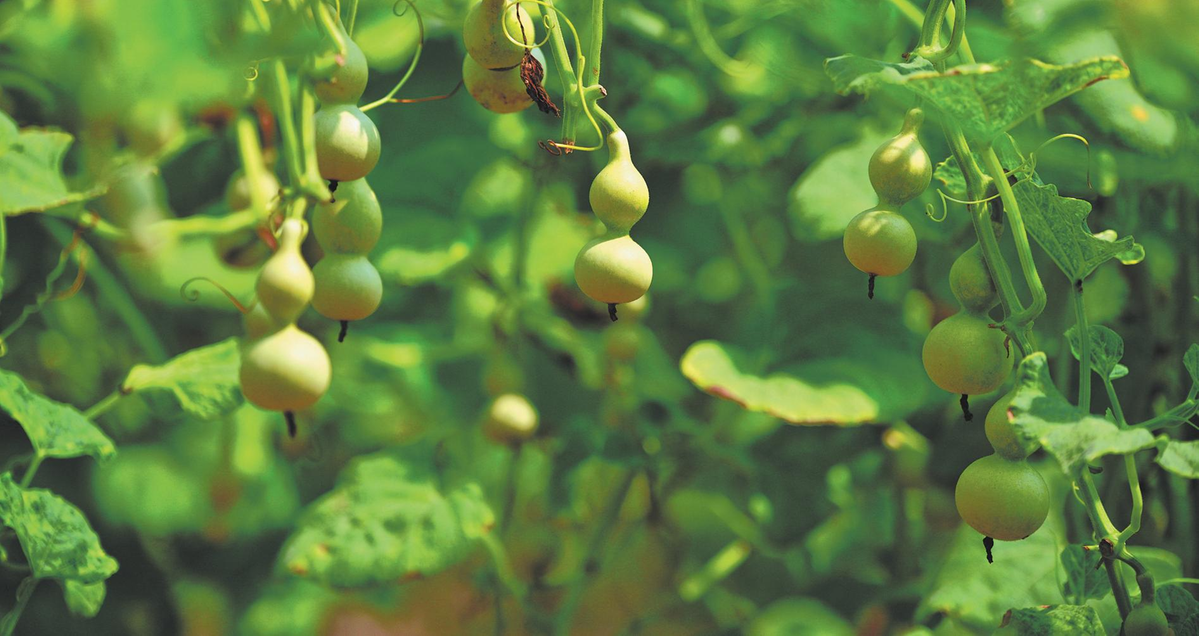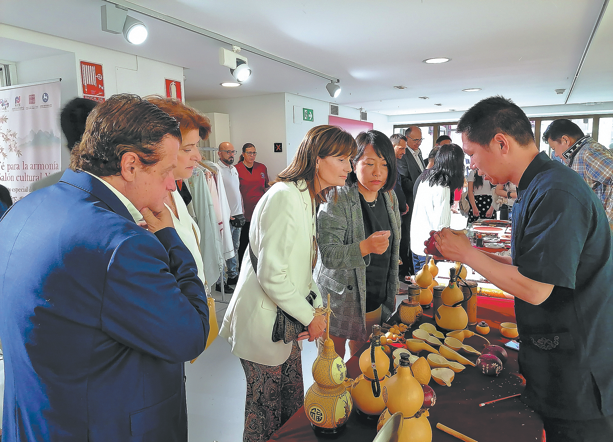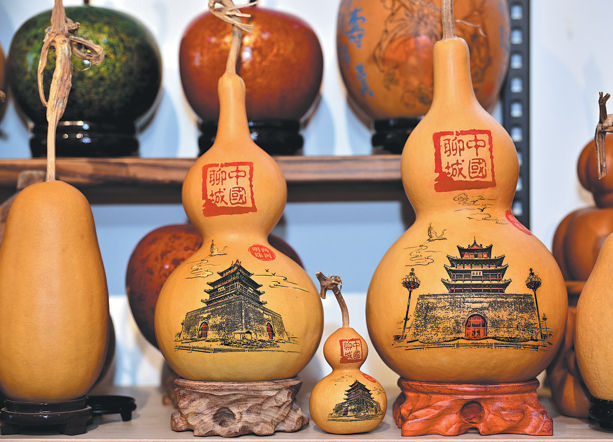Good gourd! It's great business
In Dongchangfu, what was once a humble crop has blossomed into a symbol of artistry and shared prosperity, Zhao Ruixue reports.


Walking through the bustling markets in autumn, the gourd harvest season in Dongchangfu district of Liaocheng, Shandong province, one is greeted by a vivid display of the fruit in various shapes and artistic forms.
Alongside unadorned pieces and finely carved traditional works are rare varieties such as the crane-head gourd. Yet, the real sign of the times lies in the emergence of cultural and creative products made from gourds, like gourd-themed backpacks, fridge magnets and storage jars, integrating this ancient craft into contemporary daily life.
Local records trace gourd cultivation in Dongchangfu back to the Han Dynasty (206 BC-AD 220), with refined processing techniques developing during the Song Dynasty (960-1279).
The Ming (1368-1644) and Qing (1644-1911) dynasties brought a golden age, as the busy trade along the Beijing-Hangzhou Grand Canal, which passes through the district, infused the local craft with diverse influences — southern delicacy, northern boldness and exotic motifs.
This long and rich heritage earned Dongchang gourd carving recognition as a national intangible cultural heritage in 2008. But rather than remaining frozen in time, the craft continues to evolve dynamically.
Today, the district's gourd cultivation covers over 2,000 hectares, involving more than 5,000 farming households. It commands 75 percent of the domestic market, generating annual gross revenues of 2.6 billion yuan ($365.2 million), according to Liaocheng city authorities.
A new generation is ensuring that this centuries-old craft not only survives but thrives.
Among them is Hao Hongle, the first university graduate in his village to return home, having studied business at a university in Chongqing and graduated in 2013.
The 35-year-old initially worked as a sales manager in Hubei province but returned to Luzhuang village in Tangyi town in 2014 to be closer to his parents. Upon returning, he joined the local gourd trade, which was then limited to four or five traditional varieties.
In 2018, Hao visited Tianjin to explore market trends and encountered a special gourd variety.
"This gourd is only as long as a finger, with a well-proportioned shape and smooth skin that develops a fine patina easily — highly sought-after among collectors. What's more, it yields abundantly and offers better returns," says Hao.
Hao brought the gourd back home, carefully extracted its seeds, and began cultivating it on a small plot of his family's land.
Through soil improvement, optimized irrigation and precise light control, Hao significantly enhanced the quality of his gourds. Today, a single vine can produce over 100 gourds, of which around 20 are of premium quality.
"A high-grade gourd sells for 25 yuan, and an ordinary one for 2.5 yuan," he says.
His success has inspired many villagers to learn his cultivation techniques, and his fields now serve as demonstration plots.
Dongchangfu district has established a gourd variety protection and improvement team, collaborating with scientific research institutions such as the Shandong Academy of Agricultural Sciences and Liaocheng University. Together, they have refined 17 local gourd varieties and developed more than 10 new ones.
High-quality gourds have provided materials for artistic expression.
"A wide range of topics like landscapes and images can be carved on gourds," says Wang Shufeng, director of the Liaocheng gourd cultural industry association and a provincial-level inheritor of Dongchang gourd carving.
Wang, who studied under national-level inheritor Li Yucheng, now passes on his craft through free training courses that have nurtured three city and five district-level inheritors.
To further promote the inheritance of this art, the district has set up dedicated craft workshops staffed with professional instructors. This initiative has trained over 3,300 local artisans, ensuring that skills continue to flourish.
In one such workshop in Mishi Street, Liu Jinghui, 35, uses soft clay to adorn gourds with pop-culture figures — from the animated hero Nezha to trendy toys like Labubu.
"Traditional pieces attract collectors, but I want gourds to be part of young people's daily lives," she says. Her shop has become a popular check-in spot, drawing crowds every weekend.
In addition to traditional motifs like flowers and birds, young artisans have developed diverse cultural and creative products including gourd ornaments and containers.
These innovative designs have attracted buyers from across China, with the digital economy amplifying their reach.
At 10 pm, Luzhuang village remains lively as young Hao Xuekun begins his nightly livestream.
"Take a look at this gourd — perfect shape, smooth skin and handcrafted pyrography by our master artisans," the 26-year-old enthusiastically tells his online audience.
Born into a family with generations of gourd expertise, Hao began filming gourd-related comedy sketches during university, gradually gaining followers.
After graduating in 2021, he returned home to focus on livestreaming. His humorous and informative content now draws more than 300,000 followers on short-video platforms, generating impressive sales of 100 to over 300 orders each night and annual sales of up to 700,000 to 800,000 yuan.
Dongchangfu has developed a multidimensional sales model integrating online and offline channels. Annual online gourd sales in Tangyi town have reached 1.2 billion yuan, with offline sales at 600 million yuan.
A robust logistics network supports this trade, with Luzhuang village alone dispatching over 3,000 packages daily, increasing to 6,000 during peak seasons.
Beyond domestic success, Dongchang gourds have also gained international appeal along the Belt and Road routes.
Wang, the Liaocheng gourd cultural industry association director, says Dongchang gourd carving products have been exported to more than 10 countries, including Italy, Serbia, Japan, South Korea and the United States.
"At cultural exchange events, small gourd items such as tea strainers and bracelets are especially popular among visitors," says Wang.
A complete industrial ecosystem has emerged in the district, he says.
Flawless gourds are collected by connoisseurs while those with minor imperfections become unique artworks through carving or painting. Supporting shops sell beads, tassels and tools. Even the once-discarded gourd skin is now used in traditional Chinese medicine.
This gourd boom has brought tangible benefits to villagers, helping boost local incomes and vitalize rural life. The district government has built on this momentum by promoting integrated development, creating demonstration zones where visitors can experience gourd farming, carving and painting firsthand.


Today's Top News
- Lawmakers' thousands of proposals receive responses
- China warns Japan against interference
- Nation's euro bond sale shows investors' confidence
- No soft landing for Tokyo's hard line
- Commerce minister urges US to increase areas of cooperation
- Strong demand for China's sovereign bonds signals global confidence






























